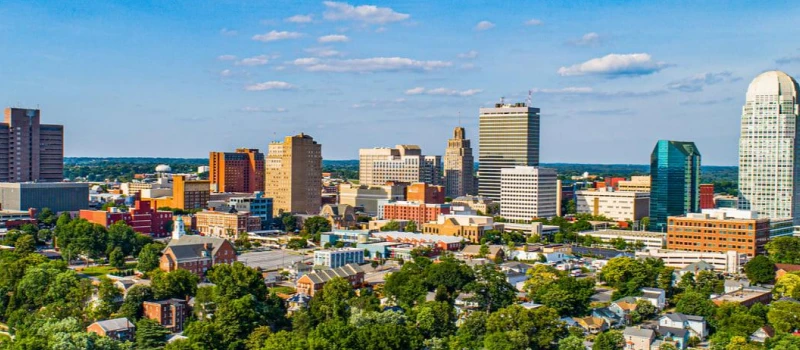
How States Compare By The Shortage of Mental Health Professionals And How Much They Fall Short

Written By: Jane Allison Gunn
January 28, 2023
8 min.
Charlie Health investigated how every state ranks in the shortage of mental health professionals and what it would take to close the shortfall using data from the Health Resources and Services Administration and the Census Bureau.
Learn more about our Clinical Review Process
Even though the demand for virtual mental health services exploded in 2020, 37 states have reported shortages in quality mental health care availability. The Department of Health and Human Services, or DHHS, projects a deficit equalling nearly 27,000 full-time jobs across nine professions, including psychiatrists, nurse practitioners, therapists, and social workers, by 2025.
The DHHS also employed Substance Abuse and Mental Health Services Administration data from the 2013 National Survey on Drug Use and Health to project an alternative scenario—one far more alarming. With SAMSHA data incorporated, the country will be short 250,510 people in nine critical mental health professions by 2025. Population growth, aging, economic conditions, and the geographic location of the health workforce are some of the many factors that could lead to such shortages.
The Health Resources and Services Administration, which is charged with improving access to quality mental healthcare for isolated and/or financially vulnerable communities, oversees programs that allocate educational resources as well as clinical training integrating mental health care with primary care.
Charlie Health investigated how every state ranks in the shortage of mental health professionals and what it would take to close the shortfall using data from the Health Resources and Services Administration and the Census Bureau. States are ranked by the percentage of counties with a mental health professional shortage.
Only geographic areas with a fully designated shortage status and listed ratio of patients to providers were included in the list. The following states are not included because they do not currently have any counties or census tracts designated with mental health professional shortages: Arkansas, Connecticut, Delaware, Washington D.C., Kentucky, Massachusetts, New Hampshire, New Jersey, New Mexico, North Dakota, Rhode Island, South Carolina, Vermont, and Wyoming.
Research suggests that training mental health workers in community-based settings—and rural areas that often experience shortages—is likely to produce providers willing to serve these high-need areas during their careers. Focusing resources in states with the most significant lack of mental healthcare providers could eliminate more than 40% of the projected shortages. Seven states have more than half of the counties with shortages. Six of these seven states are in the Midwest, where communities are generally more spread apart, which can impede access to a mental health care provider. Keep reading to learn where shortages are worst.
Do you need more support with
your mental health?
Charlie Health can help.

#37. Wisconsin
– Population in mental health professional shortage areas: 0.39% (22,845 people)
– Median patient-to-professional ratio in shortage areas: 1 for every 53,753 professionals
– Median goal patient-to-professional ratio: 1 for every 30,000
– Difference between actual and goal ratio: 23,753

#36. Florida
– Population in mental health professional shortage areas: 0.47% (101,823 people)
– Median patient-to-professional ratio in shortage areas: 1 for every 40,729 professionals
– Median goal patient-to-professional ratio: 1 for every 30,000
– Difference between actual and goal ratio: 10,729

#35. Montana
– Population in mental health professional shortage areas: 0.53% (5,897 people)
– Median patient-to-professional ratio in shortage areas: 1 for every 11,794 professionals
– Median goal patient-to-professional ratio: 1 for every 9,000
– Difference between actual and goal ratio: 2,794

#34. New York
– Population in mental health professional shortage areas: 0.60% (119,569 people)
– Median patient-to-professional ratio in shortage areas: 1 for every 75,787 professionals
– Median goal patient-to-professional ratio: 1 for every 30,000
– Difference between actual and goal ratio: 45,787

#33. Pennsylvania
– Population in mental health professional shortage areas: 0.61% (79,196 people)
– Median patient-to-professional ratio in shortage areas: 1 for every 35,594 professionals
– Median goal patient-to-professional ratio: 1 for every 30,000
– Difference between actual and goal ratio: 5,594

#32. Arizona
– Population in mental health professional shortage areas: 0.73% (52,947 people)
– Median patient-to-professional ratio in shortage areas: 1 for every 75,639 professionals
– Median goal patient-to-professional ratio: 1 for every 30,000
– Difference between actual and goal ratio: 45,639

#31. Oregon
– Population in mental health professional shortage areas: 1.13% (48,028 people)
– Median patient-to-professional ratio in shortage areas: 1 for every 68,611 professionals
– Median goal patient-to-professional ratio: 1 for every 30,000
– Difference between actual and goal ratio: 38,611

#30. Virginia
– Population in mental health professional shortage areas: 2.02% (174,192 people)
– Median patient-to-professional ratio in shortage areas: 1 for every 57,584 professionals
– Median goal patient-to-professional ratio: 1 for every 30,000
– Difference between actual and goal ratio: 27,584

#29. West Virginia
– Population in mental health professional shortage areas: 3.14% (56,058 people)
– Median patient-to-professional ratio in shortage areas: 1 for every 46,715 professionals
– Median goal patient-to-professional ratio: 1 for every 30,000
– Difference between actual and goal ratio: 16,715

#28. Michigan
– Population in mental health professional shortage areas: 3.91% (393,303 people)
– Median patient-to-professional ratio in shortage areas: 1 for every 59,700 professionals
– Median goal patient-to-professional ratio: 1 for every 30,000
– Difference between actual and goal ratio: 29,700

#27. Maine
– Population in mental health professional shortage areas: 4.14% (56,788 people)
– Median patient-to-professional ratio in shortage areas: 1 for every 49,456 professionals
– Median goal patient-to-professional ratio: 1 for every 30,000
– Difference between actual and goal ratio: 19,456

#26. Missouri
– Population in mental health professional shortage areas: 4.37% (269,528 people)
– Median patient-to-professional ratio in shortage areas: 1 for every 31,024 professionals
– Median goal patient-to-professional ratio: 1 for every 30,000
– Difference between actual and goal ratio: 1,024

#25. California
– Population in mental health professional shortage areas: 4.75% (1,864,445 people)
– Median patient-to-professional ratio in shortage areas: 1 for every 105,072 professionals
– Median goal patient-to-professional ratio: 1 for every 30,000
– Difference between actual and goal ratio: 75,072

#24. North Carolina
– Population in mental health professional shortage areas: 5.83% (614,743 people)
– Median patient-to-professional ratio in shortage areas: 1 for every 102,048 professionals
– Median goal patient-to-professional ratio: 1 for every 30,000
– Difference between actual and goal ratio: 72,048

#23. Maryland
– Population in mental health professional shortage areas: 10.14% (624,847 people)
– Median patient-to-professional ratio in shortage areas: 1 for every 54,008 professionals
– Median goal patient-to-professional ratio: 1 for every 30,000
– Difference between actual and goal ratio: 24,008

#22. Hawaii
– Population in mental health professional shortage areas: 11.35% (163,618 people)
– Median patient-to-professional ratio in shortage areas: 1 for every 109,079 professionals
– Median goal patient-to-professional ratio: 1 for every 30,000
– Difference between actual and goal ratio: 79,079

#21. Texas
– Population in mental health professional shortage areas: 11.39% (3,363,727 people)
– Median patient-to-professional ratio in shortage areas: 1 for every 42,109 professionals
– Median goal patient-to-professional ratio: 1 for every 30,000
– Difference between actual and goal ratio: 12,109

#20. Louisiana
– Population in mental health professional shortage areas: 11.90% (550,377 people)
– Median patient-to-professional ratio in shortage areas: 1 for every 74,564 professionals
– Median goal patient-to-professional ratio: 1 for every 30,000
– Difference between actual and goal ratio: 44,564

#19. Tennessee
– Population in mental health professional shortage areas: 13.54% (944,598 people)
– Median patient-to-professional ratio in shortage areas: 1 for every 57,116 professionals
– Median goal patient-to-professional ratio: 1 for every 30,000
– Difference between actual and goal ratio: 27,116

#18. Oklahoma
– Population in mental health professional shortage areas: 14.20% (566,076 people)
– Median patient-to-professional ratio in shortage areas: 1 for every 47,513 professionals
– Median goal patient-to-professional ratio: 1 for every 30,000
– Difference between actual and goal ratio: 17,513

#17. Mississippi
– Population in mental health professional shortage areas: 17.07% (503,475 people)
– Median patient-to-professional ratio in shortage areas: 1 for every 177,657 professionals
– Median goal patient-to-professional ratio: 1 for every 30,000
– Difference between actual and goal ratio: 147,657

#16. Ohio
– Population in mental health professional shortage areas: 17.13% (2,017,452 people)
– Median patient-to-professional ratio in shortage areas: 1 for every 52,432 professionals
– Median goal patient-to-professional ratio: 1 for every 30,000
– Difference between actual and goal ratio: 22,432

#15. Georgia
– Population in mental health professional shortage areas: 17.52% (1,891,606 people)
– Median patient-to-professional ratio in shortage areas: 1 for every 32,192 professionals
– Median goal patient-to-professional ratio: 1 for every 30,000
– Difference between actual and goal ratio: 2,192

#14. Kansas
– Population in mental health professional shortage areas: 18.90% (554,596 people)
– Median patient-to-professional ratio in shortage areas: 1 for every 50,723 professionals
– Median goal patient-to-professional ratio: 1 for every 30,000
– Difference between actual and goal ratio: 20,723

#13. South Dakota
– Population in mental health professional shortage areas: 19.53% (174,838 people)
– Median patient-to-professional ratio in shortage areas: 1 for every 71,517 professionals
– Median goal patient-to-professional ratio: 1 for every 30,000
– Difference between actual and goal ratio: 41,517

#12. Alabama
– Population in mental health professional shortage areas: 19.53% (984,262 people)
– Median patient-to-professional ratio in shortage areas: 1 for every 34,119 professionals
– Median goal patient-to-professional ratio: 1 for every 30,000
– Difference between actual and goal ratio: 4,119

#11. Washington
– Population in mental health professional shortage areas: 20.19% (1,562,227 people)
– Median patient-to-professional ratio in shortage areas: 1 for every 238,759 professionals
– Median goal patient-to-professional ratio: 1 for every 30,000
– Difference between actual and goal ratio: 208,759

#10. Minnesota
– Population in mental health professional shortage areas: 20.58% (1,174,675 people)
– Median patient-to-professional ratio in shortage areas: 1 for every 80,523 professionals
– Median goal patient-to-professional ratio: 1 for every 30,000
– Difference between actual and goal ratio: 50,523

#9. Alaska
– Population in mental health professional shortage areas: 24.30% (178,073 people)
– Median patient-to-professional ratio in shortage areas: 1 for every 70,488 professionals
– Median goal patient-to-professional ratio: 1 for every 30,000
– Difference between actual and goal ratio: 40,488

#8. Utah
– Population in mental health professional shortage areas: 26.23% (875,430 people)
– Median patient-to-professional ratio in shortage areas: 1 for every 304,668 professionals
– Median goal patient-to-professional ratio: 1 for every 30,000
– Difference between actual and goal ratio: 274,668

#7. Colorado
– Population in mental health professional shortage areas: 27.97% (1,625,866 people)
– Median patient-to-professional ratio in shortage areas: 1 for every 57,599 professionals
– Median goal patient-to-professional ratio: 1 for every 30,000
– Difference between actual and goal ratio: 27,599

#6. Nevada
– Population in mental health professional shortage areas: 29.41% (924,579 people)
– Median patient-to-professional ratio in shortage areas: 1 for every 230,707 professionals
– Median goal patient-to-professional ratio: 1 for every 30,000
– Difference between actual and goal ratio: 200,707

#5. Iowa
– Population in mental health professional shortage areas: 31.50% (1,005,699 people)
– Median patient-to-professional ratio in shortage areas: 1 for every 45,199 professionals
– Median goal patient-to-professional ratio: 1 for every 30,000
– Difference between actual and goal ratio: 15,199

#4. Indiana
– Population in mental health professional shortage areas: 31.68% (2,155,859 people)
– Median patient-to-professional ratio in shortage areas: 1 for every 74,775 professionals
– Median goal patient-to-professional ratio: 1 for every 30,000
– Difference between actual and goal ratio: 44,775

#3. Illinois
– Population in mental health professional shortage areas: 36.06% (4,568,804 people)
– Median patient-to-professional ratio in shortage areas: 1 for every 78,929 professionals
– Median goal patient-to-professional ratio: 1 for every 30,000
– Difference between actual and goal ratio: 48,929

#2. Idaho
– Population in mental health professional shortage areas: 51.33% (975,776 people)
– Median patient-to-professional ratio in shortage areas: 1 for every 51,415 professionals
– Median goal patient-to-professional ratio: 1 for every 30,000
– Difference between actual and goal ratio: 21,415
Do you need more support with
your mental health?
Charlie Health can help.

#1. Nebraska
– Population in mental health professional shortage areas: 53.57% (1,051,891 people)
– Median patient-to-professional ratio in shortage areas: 1 for every 41,059 professionals
– Median goal patient-to-professional ratio: 1 for every 30,000
– Difference between actual and goal ratio: 11,059


